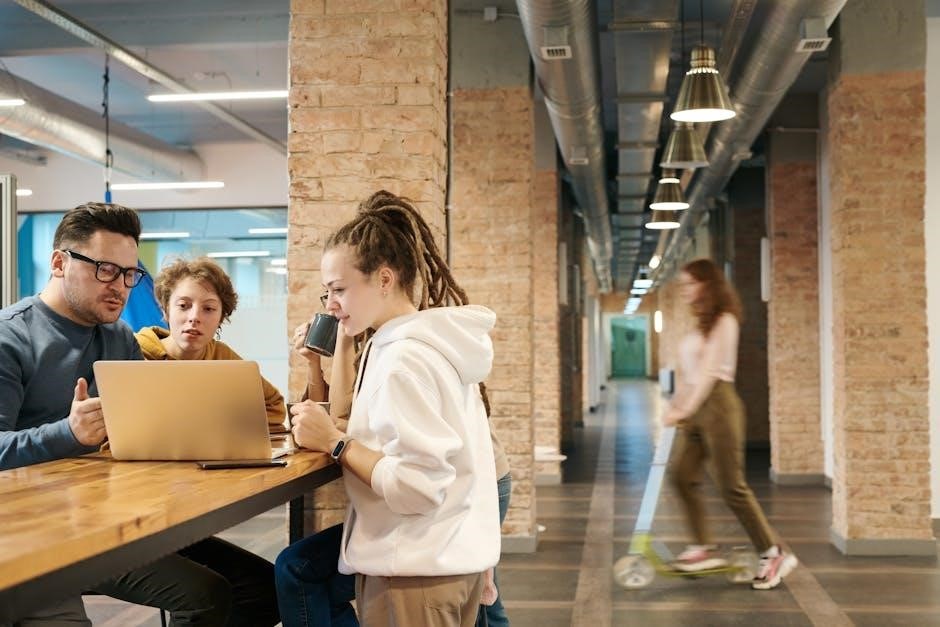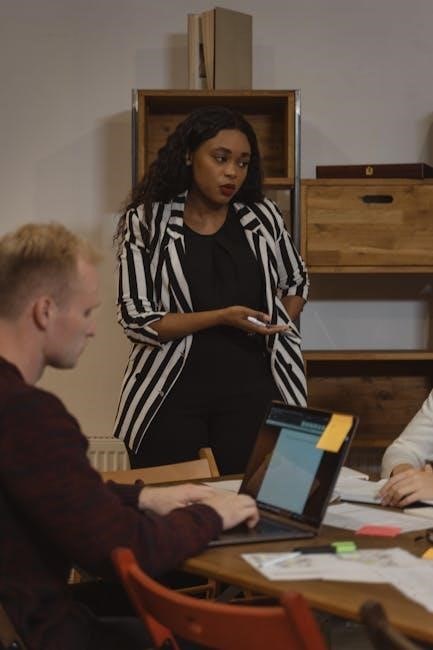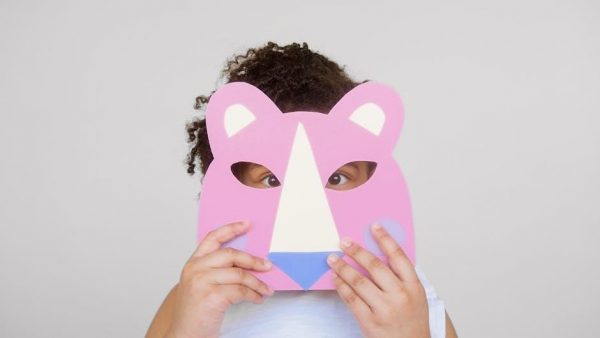Effective communication is the cornerstone of meaningful connections, enabling clear expression of ideas and fostering understanding. Leil Lowndes’ “How to Talk to Anyone” offers 92 practical techniques to enhance interpersonal skills, covering body language, conversation starters, and active listening. This guide empowers individuals to navigate social and professional interactions with confidence, ensuring messages are conveyed clearly and relationships are strengthened. By mastering these strategies, anyone can communicate more effectively, leading to personal and professional success.
Overview of “How to Talk to Anyone” by Leil Lowndes
Leil Lowndes’ “How to Talk to Anyone” is a comprehensive guide offering 92 practical tricks for improving communication skills. The book covers essential topics like body language, conversation starters, and active listening, providing readers with tools to enhance both personal and professional relationships. With its engaging and accessible approach, this 364-page guide has become a go-to resource for anyone seeking to master interpersonal interactions and build lasting connections.
Importance of Effective Communication in Relationships
Effective communication is vital for building and maintaining strong relationships, both personally and professionally. It fosters trust, understanding, and emotional intimacy, reducing conflicts and misunderstandings. By actively listening and expressing oneself clearly, individuals can create deeper connections, strengthen bonds, and navigate challenges more effectively. This foundation of clear communication ensures relationships thrive and grow, making it a cornerstone of lasting success in all aspects of life.
Mastering Body Language
Mastering body language is essential for conveying confidence and attentiveness. Align your non-verbal cues with your message to ensure clarity and build trust in your interactions.
Creating a Positive First Impression
Creating a positive first impression involves aligning your body language with approachability. Smile warmly, maintain confident posture, and engage with genuine eye contact to build instant rapport and trust.
The Role of Posture and Eye Contact
Posture and eye contact are vital in communication, conveying confidence and openness. Stand tall and avoid slouching to appear approachable. Direct eye contact shows engagement and sincerity, fostering trust. Maintain a balance between holding someone’s gaze and breaking it naturally to avoid discomfort. These non-verbal cues significantly enhance your ability to connect and communicate effectively in any interaction.
Smiling and Its Impact on Engagement
A genuine smile is a powerful tool for building connections. It conveys warmth, approachability, and sincerity, making others feel at ease. Smiling can instantly break the ice, foster trust, and create a positive atmosphere. Leil Lowndes emphasizes that a smile not only enhances your appeal but also boosts your confidence, making interactions more engaging and meaningful. It’s a simple yet effective way to connect on a deeper level in both personal and professional relationships.
Conversation Skills
Mastering conversation skills is essential for effective communication. Leil Lowndes’ guide provides tips on starting dialogues, engaging listeners, and maintaining flow. Techniques include active listening, adaptability, and using positive body language to create a welcoming environment. These strategies help build rapport and ensure meaningful exchanges, making interactions enjoyable and productive for all parties involved. By practicing these methods, anyone can become a skilled conversationalist, fostering deeper connections and understanding in various social settings.
Starting Conversations with Confidence
Starting conversations confidently involves making intentional choices. Maintain eye contact, smile warmly, and focus on your target person. Use techniques like the “Hans Horse Sense” to stay attuned to their reactions. Keep your opening engaging but simple, ensuring it invites a response. Confidence is conveyed through posture, tone, and genuine interest, making others feel comfortable and valued in the interaction. Practice these strategies to become a pro at initiating meaningful dialogues effortlessly.
Engaging Listeners and Keeping the Dialogue Flowing
Engaging listeners requires active attention and adaptability. Use techniques like maintaining eye contact and smiling to show genuine interest. Employ the “dual-track” approach: express yourself while observing your listener’s reactions. Keep conversations flowing by asking open-ended questions and responding thoughtfully. Stay attuned to their cues, adjusting your tone and pace to ensure a natural, dynamic exchange. This approach fosters connection and keeps the dialogue engaging for both parties.
Active Listening Techniques
Active listening enhances communication by focusing fully on the speaker. Maintain eye contact, nod to show understanding, and avoid interrupting. Techniques like paraphrasing and reflecting their words demonstrate empathy. Use verbal cues such as “I see” or “Go on” to encourage them to share more. By attentively listening, you build trust and ensure clear understanding, making conversations more meaningful and productive for both parties involved in the dialogue.

Handling Different Personality Types
Effective communication involves adapting to different personalities. Leil Lowndes’ techniques help in understanding and connecting with introverts, extroverts, and challenging individuals, ensuring meaningful interactions and mutual understanding.
Communicating with Introverts and Extroverts
Effective communication requires understanding personality types. Introverts thrive in quieter, one-on-one settings, while extroverts prefer lively, dynamic interactions. Leil Lowndes suggests adapting your approach by listening actively with introverts and engaging energetically with extroverts. This balance fosters mutual comfort and understanding, ensuring meaningful connections with both types. By tailoring your communication style, you can build rapport and navigate conversations seamlessly, regardless of personality differences.
Strategies for Dealing with Difficult People
When interacting with challenging individuals, remain calm and composed. Use techniques like focused attention and subtle mirroring to build rapport. Avoid taking their behavior personally and instead, practice empathetic listening. Leil Lowndes suggests maintaining eye contact while letting the other person feel heard. By staying patient and adaptable, you can de-escalate tensions and steer conversations toward positive outcomes, ensuring effective communication even in tough situations.

Networking and Social Interactions
Mastering networking and social interactions involves approaching people with confidence and using strategies to create meaningful connections. Leil Lowndes provides tips for engaging others effectively in various settings.
Approaching People at Social Events
Approaching people at social events can be daunting, but Leil Lowndes offers practical advice. She suggests maintaining eye contact with your target person, even when others are speaking, to show focus and interest. Smiling and using open body language can make you appear approachable. Starting with a light conversation starter or compliment can ease tension and create a positive first impression, helping to build rapport quickly.
Effective Strategies for Networking
Effective networking involves preparation and authenticity. Leil Lowndes suggests being approachable by smiling and using open body language. Listen actively and ask thoughtful questions to show genuine interest. Prepare conversation starters tailored to the event or audience. Following up with new contacts strengthens connections. These strategies help build meaningful relationships and expand professional and social circles, making networking both productive and enjoyable.

Building Confidence
Building confidence involves developing a positive mindset and practicing effective communication techniques. Preparation and self-awareness help individuals feel more secure in social interactions and professional settings.
Developing a Positive Mindset
Cultivating a positive mindset is crucial for effective communication. It involves embracing self-belief, focusing on strengths, and maintaining an optimistic outlook. Techniques like visualization and affirmations can help individuals stay confident. By adopting a “can-do” attitude, people can approach conversations with enthusiasm and resilience. A positive mindset also fosters adaptability, allowing individuals to navigate diverse social scenarios with ease and grace, as highlighted in Leil Lowndes’ practical communication strategies.
Preparation and Practice
Preparation and consistent practice are essential for mastering communication skills. Rehearsing conversation starters and understanding body language cues ensures confidence. Leil Lowndes’ techniques, like “dual track listening,” encourage focusing on both speaking and observing reactions. Regular practice helps refine these skills, making interactions more natural and engaging. By dedicating time to prepare and practice, individuals can confidently apply these strategies in various social and professional settings, leading to greater success in building meaningful connections.
Non-Verbal Communication
Non-verbal cues like gestures, facial expressions, and eye contact significantly influence interactions. Leil Lowndes emphasizes the importance of proximity and personal space in conveying comfort and attentiveness, fostering connection and trust in conversations.
The Power of Gestures and Facial Expressions
Gestures and facial expressions are powerful non-verbal tools that convey emotions and intentions. They enhance communication by adding depth and authenticity to interactions. Leil Lowndes highlights their role in making a positive first impression, as they naturally align with verbal messages, fostering trust and engagement. Being mindful of these cues can significantly improve how others perceive and respond to you in social and professional settings.
Proximity and Personal Space
Proximity and personal space play a crucial role in non-verbal communication. Standing too close can make others uncomfortable, while keeping too much distance may signal disinterest. Adjusting your physical closeness appropriately helps build rapport and trust. Respecting personal space ensures conversations feel natural and relaxed, fostering genuine connections and effective communication in both personal and professional interactions.

Adapting Communication Styles
Adapting your communication style to your audience ensures clarity and engagement. Tailor your approach by mirroring speech patterns, adjusting formality, and considering cultural nuances to connect effectively.
Tailoring Your Approach for Different Audiences
Tailoring your communication style to your audience is crucial for effective engagement. Adjust your tone, language, and pace to match their preferences and background. For instance, be formal with professionals and casual with friends. Use mirroring techniques to align with their speech patterns, showing empathy and understanding. This adaptability ensures your message resonates and fosters meaningful connections, making communication more impactful and relatable.
Overcoming Challenges
Mastering communication involves addressing nervousness and anxiety. Techniques like preparation, active listening, and adapting to situations help manage challenges, ensuring smooth and effective interactions with others.
Managing Nervousness and Anxiety
Managing nervousness and anxiety is crucial for effective communication. Preparation and practice help build confidence, while focusing on others through active listening reduces self-consciousness. Maintaining positive body language, such as good posture and eye contact, can also alleviate stress. Techniques like deep breathing and staying present in the moment further help calm nerves, enabling more natural and engaging interactions with others.
Recovering from Awkward Moments
Recovering from awkward moments requires grace and quick thinking. Humor can diffuse tension, as can acknowledging the awkwardness honestly. Shifting focus back to the conversation or the other person helps regain balance. Practicing resilience and confidence ensures smooth recovery, maintaining engagement and showing mastery of interpersonal dynamics, as highlighted in Leil Lowndes’ techniques for navigating social interactions effectively.
Practicing and Improving
Practicing daily and applying the 92 tricks refines skills, making interactions smoother. Consistent practice builds confidence and mastery in communication.
Daily Practice and Feedback
Daily practice is crucial for refining communication skills. Apply the 92 tricks consistently, focusing on mirroring, active listening, and adapting to others’ reactions. Seek feedback from trusted individuals to identify areas for improvement. Regular practice enhances confidence and ensures interactions become more natural and engaging. Over time, these habits will transform your ability to connect effectively with anyone, making communication second nature.
Mastering the art of communication transforms interactions, fostering deeper connections and personal growth, as highlighted in “How to Talk to Anyone.”
Summarizing Key Takeaways
Leil Lowndes’ “How to Talk to Anyone” provides 92 practical techniques to enhance communication skills, emphasizing body language, smiling, and eye contact. The book highlights the importance of active listening, adapting to personality types, and managing nervousness. By mastering these strategies, individuals can build confidence, foster meaningful connections, and achieve success in both personal and professional relationships. These insights offer a pathway to becoming a more effective and engaging communicator.
Encouragement to Apply the Techniques
Embrace the strategies from “How to Talk to Anyone” to transform your interactions. Consistent practice of these techniques will boost your confidence and enhance your ability to connect with others. By applying the principles of positive body language, active listening, and tailored communication, you can navigate any social or professional setting with ease and authenticity, leading to stronger relationships and greater personal success. Start your journey to becoming a more effective communicator today.




